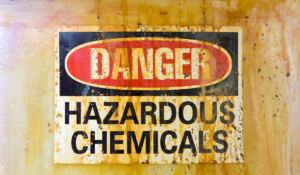When working around chemical hazards and toxic substances is a necessary part of your operation, you know you need to take extra precautions to keep your team safe.
Chemical hazards and toxic substances create poisonous environments for your workers, and cause adverse health effects for those without proper protection. Generally worksites use mitigation methods like proper ventilation and environmental monitoring to help minimize the dangers.
However, in some situations, you can’t completely eliminate exposure to certain chemical hazards and toxic substances.
In these cases, by observing OSHA standards & regulations, and by equipping your team with the proper PPE, you can protect both your workers, and your business.
Unfortunately, this was not the case with one El Paso metal-plating company, who now faces more than $292K in penalties.
So, what did they do wrong, and how could they have avoided the situation? Let’s take a look.

What Happened?
After a follow-up to an OSHA investigation in September 2022, the El Paso plant was cited for exposing workers to chemical hazards at their El Paso facility.
Incorporated in 1973, the company provides gold, silver, and nickel-plating services.
According to federal investigators, they exposed workers to serious hazards, including willfully failing to protect people working with dangerous acids and chemicals from potentially permanent eye injuries.
Now, they face a host of citations, including 12 serious and one willful violation.
As part of the investigation, OSHA inspectors also discovered blocked exits, electrical hazards, and improperly stored acetylene & oxygen cylinders on-site.
Yet, more major missteps occurred, too.
For instance, OSHA determined the company failed to establish and implement a written respiratory protection program with worksite-specific procedures. And, the company did not assess the presence or possibility of other workplace hazards to determine if personal protective equipment was required.
Finally, OSHA inspectors also discovered the company failed to implement a written hazard communication program.
Related Article: Employer’s Guide to Personal Protective Equipment – Eye & Face Protection
Previous Citations
This isn’t the first time the El Paso company has run into safety issues with OSHA.
Previously, the agency issued serious citations in September 2011, and repeat citations in August 2012, for failing to provide employees with a suitable facility for emergency flushing/drenching of the eyes and body.
Then, September 2012, the company received serious citations for failing to conduct a workplace hazard assessment, in addition to lacking required hazard communications.
Clearly, the company has continued to ignore responsibility to protect employees working around chemical hazards from serious injuries, including permanent eye damage and possible sight loss.
What’s Next?
Following the most recent citations, OSHA has proposed $292,693 in penalties.
As per regulation, the company now has 15 business days from receipt of these citations to comply, request an informal conference with OSHA’s area director, or contest the findings before the independent Occupational Safety and Health Review Commission.
Eye and Face Protection for Your Workers
There are 2.4 million eye injuries annually in America. Sadly, these injuries remain largely preventable.
In fact, an estimated 90% of such injuries remain avoidable through the use of proper eye protection.
Personal protective equipment for the face, including eye protection, remains critical to prevent or lessen the severity of workplace injuries.
Employers should provide every employee with proper protection, and ensure their use any time an employee is exposed to eye or face hazards from flying particles, molten metal, liquid chemicals, acids or caustic liquids, chemical gases or vapors, and more.
Safety Eyewear Protection Includes:
- Non-prescription and prescription safety glasses
- Goggles
- Face shields
- Full-face respirators
Note: For proper compliance, safety eyewear must have “Z87+” marked on the frame, and in some cases, the lens.
Things you should do in the workplace:
- Hazard assessment to determine the risk of exposure to eye and face hazards, including those which may be encountered in an emergency.
- Guard against eye injury by wearing appropriate protective eyewear.
- Refer to the selection chart to choose the appropriate protection.
- Ensure emergency eye wash stations are available in your workplace where employees may be exposed to particles or non-corrosive liquids or chemicals.
- Protect your eyes around other coworker’s or subcontractor’s work zones.
For OSHA’s exact standards on eye and face protection standards, check out:
- Personal Protective Equipment: Eye and face protection- 133, and
- Personal Protective and Life Saving Equipment: Eye and face protection- 102.
Bringing It Together
Chemical hazards should never be treated with levity or overlooked by employers.
Not only do they present tremendous dangers to your team, but OSHA fines are becoming increasingly expensive to deal with. And, if you find yourself on the wrong side of an OSHA inspection, you may experience even closer scrutiny down the road.
Protect your workers, keep your worksite safe, and both your business & team will reap the rewards.
***
About Worksite Medical
In most cases, OSHA requires medical surveillance testing, and at no cost to employees.
Worksite Medical makes that program easier with mobile medical testing.
We conduct on-site respirator fit tests, as well as audiometric exams, pulmonary function tests and heavy metal lab work, right on your job site. We also keep accurate, easy-to-access medical records for your convenience. You’ll keep your employees at work, and stay ahead of OSHA inspections.




